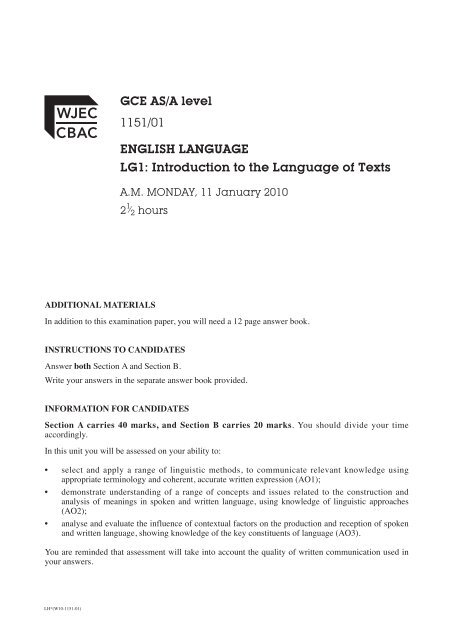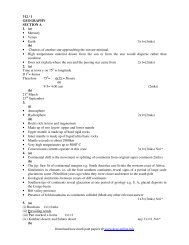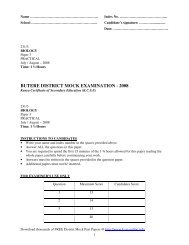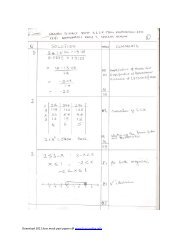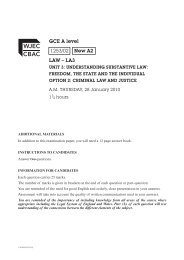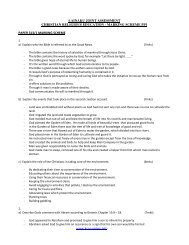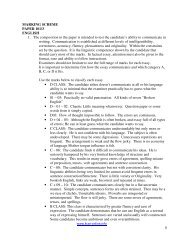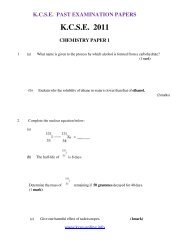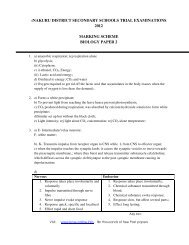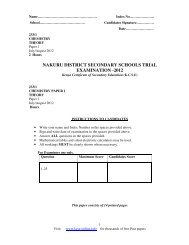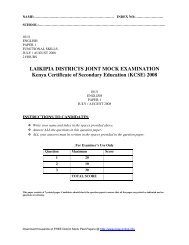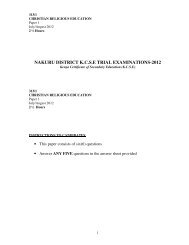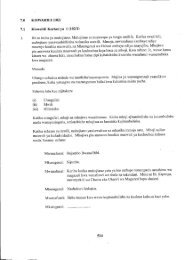new spec - gce winter 2010 - question paper - KCSE Online
new spec - gce winter 2010 - question paper - KCSE Online
new spec - gce winter 2010 - question paper - KCSE Online
Create successful ePaper yourself
Turn your PDF publications into a flip-book with our unique Google optimized e-Paper software.
GCE AS/A level<br />
1151/01<br />
ENGLISH LANGUAGE<br />
LG1: Introduction to the Language of Texts<br />
A.M. MONDAY, 11 January <strong>2010</strong><br />
2 1 ⁄ 2 hours<br />
ADDITIONAL MATERIALS<br />
In addition to this examination <strong>paper</strong>, you will need a 12 page answer book.<br />
INSTRUCTIONS TO CANDIDATES<br />
Answer both Section A and Section B.<br />
Write your answers in the separate answer book provided.<br />
INFORMATION FOR CANDIDATES<br />
Section A carries 40 marks, and Section B carries 20 marks. You should divide your time<br />
accordingly.<br />
In this unit you will be assessed on your ability to:<br />
• select and apply a range of linguistic methods, to communicate relevant knowledge using<br />
appropriate terminology and coherent, accurate written expression (AO1);<br />
• demonstrate understanding of a range of concepts and issues related to the construction and<br />
analysis of meanings in spoken and written language, using knowledge of linguistic approaches<br />
(AO2);<br />
• analyse and evaluate the influence of contextual factors on the production and reception of spoken<br />
and written language, showing knowledge of the key constituents of language (AO3).<br />
You are reminded that assessment will take into account the quality of written communication used in<br />
your answers.<br />
LH*(W10-1151-01)
2<br />
SECTION A<br />
The Language of Texts<br />
This Section counts for 40 marks, and you should devote an appropriate proportion of your<br />
time to it.<br />
The following two texts are about the assassination of Abraham Lincoln, America’s 16 th President.<br />
Text A is from the front page of The New York Tribune, published on Saturday, 15 th April, 1865. It<br />
reports <strong>new</strong>s of the assassination of President Abraham Lincoln as it was received by the<br />
<strong>new</strong>s<strong>paper</strong>, in a series of dispatches.<br />
Text B is from an eye-witness account of President Lincoln’s final hours. It was given by Gideon<br />
Welles, Lincoln’s Secretary of the Navy.<br />
Analyse the use of language in these texts.<br />
In your answer you should:<br />
• analyse and explore the use of language to convey information about the shooting and death<br />
of President Abraham Lincoln;<br />
• consider in what ways the writers use language to reveal their attitudes and thoughts about<br />
the assassination of Lincoln;<br />
• include some consideration of similarities and/or differences between the texts.<br />
(40 Marks)<br />
(1151-01)
3<br />
TEXT A: (from The New York Tribune)<br />
5<br />
10<br />
15<br />
20<br />
25<br />
30<br />
HIGHLY IMPORTANT!<br />
The President Shot!<br />
Secretary Seward attacked.<br />
SIXTH DISPATCH.<br />
Special Dispatch to The N.Y. Tribune<br />
Washington, Friday, April 14, 1865<br />
Like a clap of thunder out of clear sky spread the<br />
announcement that President Lincoln was shot<br />
while sitting in his box at Ford’s Theatre. The<br />
city is wild with excitement. A gentleman who<br />
was present thus describes the event: At about 10<br />
o’clock, in the midst of one of the acts, a pistol<br />
shot was heard, and at the same instant a man<br />
leaped upon the stage from the same box<br />
occupied by the President, brandished a long<br />
knife, and shouted, “Sic semper tyrannis!”[“Thus<br />
always to tyrants”] then rushed to the rear of the<br />
scenes and out of the back door of the theatre. So<br />
sudden was the whole thing that most persons in<br />
the theatre supposed it a part of the play, and it<br />
was some minutes before the fearful tragedy was<br />
comprehended. The man was pursued, however,<br />
by someone connected to the theatre to the outer<br />
door and seen to mount a horse and ride rapidly<br />
away. A regiment of cavalry have started in all<br />
directions, with orders to arrest every man found<br />
on horseback. Scarce had the <strong>new</strong>s of this horror<br />
been detailed, when couriers came from<br />
Secretary Seward’s, announcing that he also had<br />
been assassinated. The following are the<br />
authentic particulars:<br />
SEVENTH DISPATCH<br />
Special Dispatch to The N.Y. Tribune<br />
Washington, Friday, April 14, 1865<br />
The President attended Ford’s Theatre to-night,<br />
and about 10 o’clock an assassin entered his<br />
private box and shot him in the back of the head.<br />
The ball lodged in his head, and he is now lying<br />
insensible in a house opposite the theatre. No<br />
hopes are entertained of his recovery. Laura<br />
Keene claims to have recognised the assassin as<br />
the actor, J. Wilkes Booth. A feeling of gloom<br />
like a pall has settled on the city.<br />
EIGHTH DISPATCH<br />
Special Dispatch to The N.Y. Tribune<br />
Washington, Friday, April 14, 1865<br />
The assassin is said to have gained entrance to<br />
the President’s box by sending in his card<br />
requesting an interview. The box was occupied<br />
by Mrs Lincoln and Col. Parker of Gen. Grant’s<br />
staff. The villain drew his pistol across Mrs<br />
Lincoln’s shoulder and fired. Col. Parker sprang<br />
up and seized the assassin, but he wrested<br />
himself from his grip and sprang down on the<br />
stage as described. His spur caught the American<br />
flag as he descended, and threw him at length.<br />
He unloosed the spur and dashed to the rear,<br />
brandishing his knife and revolver.<br />
.....................................<br />
ELEVENTH DISPATCH.<br />
Special Dispatch to The N.Y. Tribune<br />
Washington, Friday, April 14, 1865 1.15 a.m.<br />
The President is slowly dying. The brain is<br />
slowly oozing through the ball hole in his<br />
forehead. He is of course insensible. There is an<br />
occasional lifting of his hand, and heavy<br />
stentorous breathing; that’s all.<br />
35<br />
40<br />
45<br />
50<br />
55<br />
60<br />
65<br />
Reproduced from www.historybuff.com<br />
(1151-01)<br />
Turn over.
TEXT B: (from "The Death of President Lincoln, 1865," EyeWitness to History,<br />
www.eyewitnesstohistory.com (1999).)<br />
4<br />
5<br />
10<br />
15<br />
20<br />
25<br />
30<br />
35<br />
40<br />
"The President had been carried across the street from the theater to the house of a Mr. Peterson.<br />
We entered by ascending a flight of steps above the basement and passing through a long hall to the<br />
rear, where the President lay extended on a bed, breathing heavily. Several surgeons were present,<br />
at least six, I should think more. Among them I was glad to observe Doctor Hall, who, however,<br />
soon left. I inquired of Doctor Hall, as I entered, the true condition of the President. He replied the<br />
President was dead to all intents, although he might live three hours or perhaps longer.<br />
The giant sufferer lay extended diagonally across the bed, which was not long enough for him. He<br />
had been stripped of his clothes. His large arms, which were occasionally exposed, were of a size<br />
which one would scarce have expected from his spare appearance. His slow, full respiration lifted<br />
the clothes with each breath that he took. His features were calm and striking. I had never seen<br />
them appear to better advantage than for the first hour, perhaps, that I was there. After that his right<br />
eye began to swell and that part of his face became discoloured.<br />
Senator Sumner was there, I think, when I entered. If not he came in soon after, as did Speaker<br />
Colfax, Mr. Secretary McCulloch, and the other members of the cabinet, with the exception of Mr.<br />
Seward. A double guard was stationed at the door and on the sidewalk to repress the crowd, which<br />
was of course highly excited and anxious. The room was small and overcrowded. The surgeons and<br />
members of the cabinet were as many as should have been in the room, but there were many more,<br />
and the hall and other rooms in the front or main house were full. One of these rooms was occupied<br />
by Mrs. Lincoln and her attendants, with Miss Harris. Mrs. Dixon and Mrs. Kinney came to her<br />
about twelve o'clock. About once an hour Mrs. Lincoln would repair to the bedside of her dying<br />
husband and with lamentation and tears remain until overcome by emotion.<br />
A door which opened upon a porch or gallery, and also the windows, were kept open for fresh air.<br />
The night was dark, cloudy, and damp, and about six it began to rain. I remained in the room until<br />
then without sitting or leaving it, when, there being a vacant chair which some one left at the foot<br />
of the bed, I occupied it for nearly two hours, listening to the heavy groans and witnessing the<br />
wasting life of the good and great man who was expiring before me.<br />
About 6 A.M. I experienced a feeling of faintness, and for the first time after entering the room a<br />
little past eleven I left it and the house and took a short walk in the open air. It was a dark and<br />
gloomy morning, and rain set in before I returned to the house some fifteen minutes later. Large<br />
groups of people were gathered every few rods¹, all anxious and solicitous. Some one or more from<br />
each group stepped forward as I passed to inquire into the condition of the President and to ask if<br />
there was no hope. Intense grief was on every countenance when I replied that the President could<br />
survive but a short time. The coloured people e<strong>spec</strong>ially - and there were at this time more of them,<br />
perhaps, than of whites - were overwhelmed with grief.<br />
A little before seven, I went into the room where the dying President was rapidly drawing near the<br />
closing moments. His wife soon after made her last visit to him. The death struggle had begun.<br />
Robert, his son, stood with several others at the head of the bed. He bore himself well but on two<br />
occasions gave way to overpowering grief and sobbed aloud, turning his head and leaning on the<br />
shoulder of Senator Sumner. The respiration of the President became suspended at intervals and at<br />
last entirely ceased at twenty-two minutes past seven".<br />
¹rods: a term of measurement (approximately 5 metres)<br />
(1151-01)<br />
Reproduced by permission of www.eyewitnesstohistory.com
5<br />
BLANK PAGE<br />
(1151-01)<br />
Turn over.
6<br />
SECTION B<br />
Language Focus<br />
This Section counts for 20 marks, and you should devote an appropriate proportion of your<br />
time to it.<br />
The following text is from a book entitled Just Can’t Get Enough: Toys, Games and Other Stuff<br />
from the '80s That Rocked, published in 2007.<br />
The text is about a popular toy from the 1980s, The Ewok Village.<br />
Task:<br />
Analyse and discuss the use of language in this text to convey the attitude of the writer towards the<br />
Ewok Village.<br />
You should consider in your answer:<br />
• how the language choices convey the enthusiasm of the writer;<br />
• how the language is used to fondly remember this popular toy from the 1980s.<br />
(20 Marks)<br />
(1151-01)
7<br />
Ewok Village - Nyub-Nyub City!<br />
If you were a boy and didn’t have the Ewok Village in the ‘80s, you were a loser.<br />
5<br />
10<br />
15<br />
20<br />
25<br />
30<br />
35<br />
Why Because the Ewok Village was rad. It was a well-designed, well-crafted oversized play set<br />
that could easily accommodate action figures from all walks of life, making it one of the central<br />
hubs of any self-re<strong>spec</strong>ting kid’s toy collection.<br />
The Ewok Village play set was a world of limitless possibilities for the creative (or not so creative)<br />
playtime enthusiast: you could roast Han Solo over a painted flame, parade C3PO around like a<br />
god on the shoulders of Ewoks, swoop up a few storm troopers in the mesh net or even invite<br />
Hachiman from Thundercats and a few of the M.U.S.C.L.E. men over for tea and then send them<br />
flying down the Ewok escape chute at your slightest whim.<br />
What is it A Star Wars action-figure play set based on the Ewok Village from the movie Star<br />
Wars: The Return of the Jedi.<br />
When was it out First released in 1983.<br />
Who made it Kenner<br />
Who was it for Boys and girls ages five and up, and nerds of all ages.<br />
Is it still around today Nope, but you’ll run into one occasionally on eBay or at a local garage<br />
sale.<br />
The Product<br />
What exactly made the Ewok Village so desirable Was it the high price Not really. The Ewok<br />
Village wasn’t anywhere near the house-mortgaging prices of the G.I. Joe Aircraft Carrier or the<br />
Nintendo Entertainment system with R.O.B. In its day, the Ewok Village cost around $19.95,<br />
which is probably equivalent to somewhere in the $50 price range today.<br />
Was it simply the fact that it was affiliated with the Star Wars universe that made the Ewok Village<br />
so desirable Not really. Most kids weren’t able to purchase every single Star Wars toy available<br />
and yet almost every kid had the Ewok Village. Sure, we all had a few Luke Skywalkers or Darth<br />
Vaders lying around, maybe a toy light sabre here or there, or the occasional figure carrying case in<br />
the shape of C3PO’s head. But the sheer size of the Star Wars toy line made it nearly impossible for<br />
every kid to own every Star Wars toy; yet, everyone owned the Ewok Village.<br />
So what made the Ewok Village such a must have toy in the ‘80s Two things: its size and its<br />
design. The size of a toy plays a huge part in its toy-store-attention-grabbing potential. Well, the<br />
Ewok Village was the Trump Tower of toy-shelf real estate. It was massive and stood out like a<br />
sore thumb among the rest of the Star Wars toys. Seeing that massive toy box on the shelves and<br />
that parent-friendly price tag made it a nearly impossible deal to pass up. And why would you want<br />
to The thing came with a plastic boulder, for crying out loud.<br />
Regardless of the size of the Ewok Village, the toy itself was simply a well-designed product. The<br />
Ewok Village stood about a foot off the ground, making for a sturdy, level surface on which to<br />
stand up your action figures. For kids like myself who had carpeted bedrooms, a play set that acted<br />
like a tabletop was extremely helpful if you wanted to get a figure standing up on its own.<br />
Reproduced from ‘Just Can’t Get Enough’ by Matthew Robinson and Jenson Karp, 2007 (HNA Books)<br />
(1151-01)


